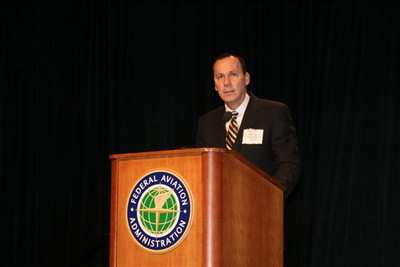The FAA Aviation Forecast Conference is one of the most
anticipated events on the FAA calendar. If you want to know where
the pulse of aviation lies and where things are headed, it’s
right here for the next two days.
The pulse is strong and healthy. Looking at the industry today,
load factors remain high. Fact is, they’ve gone through the
roof in the last five years. We’ve had an almost 10-point
gain since 2002. That culminated in a record last year, with 765
million passengers, or more than 2 million a day. People want to
fly.
There’s also an interesting development unfolding within
different segments of the market. The airline business is solid in
certain geographic areas. That, unfortunately, contributes to
congestion. Meanwhile, the carriers are pulling back elsewhere.

These dynamics are forcing the industry as a whole to respond in
ways to congestion we’ve never had to before. We’ll
hear more about this in this morning’s first panel
discussion.
And, later this morning, Secretary Peters will make a major
announcement on the congestion front.
But, the story for 2008 is clear. The fundamentals of the
industry — continued growth, cheap ticket prices — are
vibrant down the road. With that said, in the near term,
we’re seeing a definite pause in growth. We didn’t have
one in last year’s forecast. But this year, it’s pretty
clear. We’re talking flat growth in operations, and slow
growth in passengers.
What that means is that our 1 billion mark slips a year, from
2015 to 2016.
 So, the question there
is "why?” Why the pause? Well, it’s a series of
cascading events, really. A hundred dollars for oil, an economic
picture that’s in flux, potential consolidations, and credit
market woes. That credit crunch even spurred IATA to cut its global
air traffic forecasts for ’08.
So, the question there
is "why?” Why the pause? Well, it’s a series of
cascading events, really. A hundred dollars for oil, an economic
picture that’s in flux, potential consolidations, and credit
market woes. That credit crunch even spurred IATA to cut its global
air traffic forecasts for ’08.
Even still, the demand for aviation services will continue to
rise in the long run. Over the next few years, international
markets will grow twice as fast as domestic markets.
We see a definite change in the regional carrier industry, with
a trend to more larger RJs that have over 50 seats.
And, there’s still a big tailwind for corporate
aviation.
All of this activity has implications for various airports. From
an operations standpoint, we predict that, on average, every year,
from now until 2025, we’re going to add the equivalent of
JFK, LaGuardia and Newark combined into the system.
That means an already congested airspace has got to be able to
accommodate that many more ops per year. When you say things like
that, the cynics will tell you immediately that the sky is falling.
That’s not the case, because we can meet the demand if we
transform the way we do business. It’s called NextGen, the
Next Generation of air traffic control.
It takes us from a ground-based operation into the satellite
era, with a system that’s much more automated. The
congestion, the delays, the inefficiency — they all add up to
why we need to make this move. And now.
I’m proud of the fact that the journey to NextGen is
already underway. It’s coming more into being each day.
We’re ramping things up. We’re accelerating NextGen
routes — RNP and RNAV — into busy areas like Chicago,
DFW, D.C. and New York.
Required navigation performance and area navigation are
capabilities that use an aircraft’s onboard technology and
GPS to fly more accurate and predictable flight paths. They
increase navigation accuracy. They improve safety. And, they
improve efficiency. It doesn’t get much better than that.

In fact, we’ve increased our production of RNP approaches
this year, from 50 to 69.
Over in the Gulf of Mexico, we’re going to add ADS-B
coverage so that planes can fly closer together without
compromising safety. This ensures more efficiency and capacity.
What it means for the Gulf is this — for the first time,
not only will we be providing air traffic control services to
low-altitude helicopter operators, which go to and from the oil
platforms. But we’ll also be setting up ADS-B high altitude
routes as well.
From the Gulf we go to the busiest airspace in the country, New
York.
We’re deploying the Traffic Management Advisor to JFK and
LaGuardia and connecting it to the Washington, D.C. area.
This will allow us to sequence incoming planes more efficiently
— from as far as 100 miles away — and achieve capacity
gains of 3-5 percent.
We’re working with the Port Authority of New York and New
Jersey to deploy what’s known as a Surface Management System
at JFK. This will improve the airlines’ ability to plan
ground operations, resulting in reduced noise, fuel and
emissions.

I could go on. But I think you’ve got a good sense for
what we’re doing in the here and now. We’re not waiting
around for the Big Bang, or a flip of the switch. NextGen is a
transformation and it’s happening now, and we’re moving
ahead.
Despite the near-term pause in growth this year, we can’t
afford to let up, and we’re not. People want to fly, plain
and simple. And the FAA is doing everything we can to keep them
flying and flying safely. The forecast for aviation? From where I
stand, it’s strong indeed. Thank you.
That’s the big picture forecast for aviation.
 ANN's Daily Aero-Linx (04.15.24)
ANN's Daily Aero-Linx (04.15.24) Classic Aero-TV: 'No Other Options' -- The Israeli Air Force's Danny Shapira
Classic Aero-TV: 'No Other Options' -- The Israeli Air Force's Danny Shapira Aero-News: Quote of the Day (04.15.24)
Aero-News: Quote of the Day (04.15.24) Airborne 04.16.24: RV Update, Affordable Flying Expo, Diamond Lil
Airborne 04.16.24: RV Update, Affordable Flying Expo, Diamond Lil ANN's Daily Aero-Term (04.16.24): Chart Supplement US
ANN's Daily Aero-Term (04.16.24): Chart Supplement US







